The Government has announced that England will move to step 4 of the roadmap out of lockdown on 19 July 2021 - aka Freedom Day. Step 4 represents the last stage in the roadmap and will see most COVID-related legal restrictions replaced by guidance. In this briefing, we consider what Freedom Day means for office-based employers.
Can we instruct staff to return to the office from 19 July 2021?
"Yes, but." is the answer to that. The "stay at home" order was lifted on 29 March 2021. While that order was in place it was a criminal offence to leave home to go to work save where it was not reasonably possible to work from home. Once that order was lifted it was no longer unlawful to leave home to go to work. However, this was not the only consideration for employers. Importantly, employers must comply with health and safety legislation and guidance, including the "Working safely during coronavirus guidelines" (Guidelines).
Earlier versions of these Guidelines had said that office workers should continue to work from home if possible until at least step 4 of the roadmap. The confirmation that step 4 will take place on 19 July 2021 means that employers may start to return workers to the office from that date. However, the new Guidelines in place from 19 July 2021 suggest that the return process should not be a one-off event. Rather, the Government "expects and recommends a gradual return over the summer".
A gradual return of the workforce could be implemented in various ways, for example, by reference to essential business needs or by asking for volunteers. Another option would be to create fixed teams of employees that attend the office on different days or weeks for a period of time. The Guidelines also acknowledge that many employers are looking at adopting permanent hybrid working practices which include an element of home working.
Employers are advised to discuss the return process with workers and remain responsive to their needs. Before returning workers to the workplace, employers should also update their risk assessments and take appropriate measures to manage the risk of COVID spreading at work. Here, particular care needs to be taken in relation to clinically extremely vulnerable workers and pregnant workers (see below).
Will we have to restrict the numbers of staff who return to the office and/or ensure staff can socially distance?
Not necessarily. From 19 July 2021 there will be no limitations on the numbers of people who can meet indoors, including in the workplace. Similarly, all social distancing restrictions will be removed. However, as discussed above, employers must still comply with their legal obligations and this includes ensuring the health, safety and welfare of staff and third parties so far as is reasonably practicable. Therefore, as part of their risk assessment, employers should consider whether some degree of social distancing would help to mitigate COVID-related risk and, if so, whether it is reasonably practicable. The Health and Safety Executive has produced a COVID template risk assessment which employers may wish to use.
The Guidelines in place from 19 July 2021 suggest that employers should consider measures to reduce contact between workers, such as assigning workers to fixed teams, using screens and using back-to-back or side-to-side working. Reduced contact could also be achieved by the use of hybrid working, with staff attendance in the workplace staggered on different days.
Will staff have to wear face coverings in the office?
No. At no point have face coverings been mandatory for workers in most kinds of office setting, although they could be used if desired. In any event, from 19 July 2021, the legal requirement to wear a face covering will be lifted in all settings.
However, the Guidelines in place from 19 July 2021 suggest that office-based employers may wish to encourage the use of face coverings by workers particularly in areas where they come into contact with people they do not normally meet. This is said to be especially important in enclosed and crowded spaces (for example, lifts and corridors). Where masks are to be used, consideration should be given to making adjustments for disabled staff and to the fact that some people are unable to wear face coverings.
How should we approach the issue of staff vaccination?
Although the Government plans to introduce mandatory vaccination for care home workers, and potentially for healthcare workers, there are no plans to do so for the wider population. The Guidelines in place from 19 July 2021 do not address the issue of staff vaccination as a means of controlling risk in the workplace. As such, it's likely to be very difficult for office-based employers to justify a requirement for staff to be vaccinated. If you would like to know about the risks of doing so, and vaccinations more generally, please view our recent webinar on the topic.
Underlining the voluntary approach, the Government has published new guidance for employers on vaccination, which is designed to help them encourage staff to be vaccinated. A toolkit is also available which includes materials for employers to use such as a Q&A document, key facts on vaccination, scripts for internal conversations and links to videos, webinars and posters. The guidance also recommends that employers take steps such as allowing staff to take time off to be vaccinated and amending sick leave policies to disregard any vaccine-related ill-health absence (which might disincentivise someone from getting vaccinated).
How should we deal with clinically extremely vulnerable workers (i.e. those who had to shield)?
The shielding guidance for clinically extremely vulnerable people was paused with effect from 1 April 2021. Earlier versions of the Guidelines had said that such individuals should work from home where possible and only attend work if they could not work from home.
There are no special rules in place for this group at stage 4 of the roadmap, meaning that employers may instruct them to return to work from 19 July 2021. However, it is recognised that affected workers may wish to continue to limit close contact in order to reduce the risk of catching COVID. The Guidelines in place from 19 July 2021 say that employers should give extra consideration to those at higher risk and "take additional precautions advised by their clinicians".
All of this means that before asking such workers to return to the workplace, employers must consider whether special measures are needed for them as part of their overall risk assessment. Employers should also bear in mind that clinically extremely vulnerable workers may well be disabled for the purposes of discrimination legislation. Where this is the case, they may also be under a duty to make reasonable adjustments to their working practices.
How should we deal with pregnant workers?
Special guidance remains in place for pregnant women which advises that a "precautionary approach" on returning to work is adopted for women who are either: (i) 28 weeks pregnant or more; or (ii) pregnant and have underlying health conditions which put them at greater risk of severe illness from COVID. This precautionary approach means that such workers should limit contact with others to minimise the risk of catching COVID. This means that many such workers will need to work from home, potentially in a different capacity if necessary. Employers must prioritise homeworking options for this group wherever possible. Where homeworking is not possible, affected women may need to be suspended from work on full pay on health and safety grounds
The position is slightly different for pregnant women who are less than 28 weeks pregnant and have no underlying health conditions. For this group, a risk assessment should be conducted, and affected women may attend the workplace provided the risk assessment says it is safe to do so. If the workplace is not safe (and cannot be made safe), then suitable alternative work or working arrangements (including working from home) may be necessary, or, again, affected women may need to be suspended from work on full pay on health and safety grounds.
What happens if a staff member contracts COVID?
If a staff member contracts COVID then they must not come to work and should self-isolate.
Similarly, anyone who:
- has COVID symptoms;
- is a close contact of someone with COVID;
- is told to self-isolate by NHS Test and Trace; or
- is "pinged" by the NHS Test and Trace app,
should self-isolate. Employers must not require self-isolating workers to attend work and must send them home if they turn up. Self-isolating workers will usually be entitled to statutory sick pay and may also be entitled to company sick pay
COVID-19 Response: Summer 2021
Working safely during coronavirus guidelines for offices, factories and labs (applicable from 19 July 2021)
The content of this article is intended to provide a general guide to the subject matter. Specialist advice should be sought about your specific circumstances.

